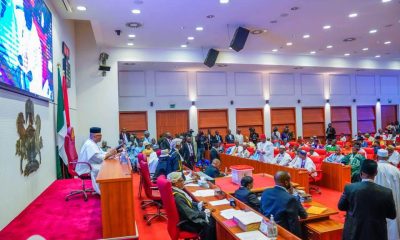Business
Nigeria’s Money Supply Soars By 17% – CBN Reports

Nigeria’s Money Supply (M2) saw a year-on-year increase of 17.3 per cent, reaching ₦110.3 trillion in February 2025, up from ₦93.97 trillion during the same month in 2024.
This information was provided by the Central Bank of Nigeria (CBN) in its recently released Money and Credit Statistics.
Naija News reports that the report also indicated a 13.4 percent year-on-year decline in credit to the economy, which fell to ₦99.4 trillion in February 2025, mainly due to lending reductions to the government and the private sector.
The CBN’s data on Money and Credit Statistics highlighted that favorable changes influenced the annual growth in the money supply in its various components.
Quasi-money, which encompasses savings deposits, time deposits, and other near-money assets, increased by 14 percent year-on-year, rising to ₦72.7 trillion from ₦63.7 trillion in February 2024.
In addition, Demand Deposits experienced a significant rise of 22.8 percent year-on-year, reaching ₦33.05 trillion in February 2025, compared to ₦26.9 trillion in February 2024.
Currency outside of banks also saw a substantial increase of 32 percent year-on-year, climbing to ₦4.51 trillion in February 2025 from ₦3.41 trillion in February 2024.
Narrow money (M1) grew by 21.7 percent year-on-year, reaching ₦36.9 trillion in February 2025, up from ₦30.3 trillion in February 2024.
A key factor contributing to the ongoing rise in the Broad Money Supply (M2) is the increase in government borrowing from the domestic market.
As reported by the CBN, credit extended to the government amounted to ₦26.5 trillion in February, reflecting a 21.8 percent year-on-year decrease from ₦33.92 trillion in February 2024.
However, on a month-on-month basis, credit to the government increased by eight percent from ₦24.5 trillion in January 2025.
An in-depth examination of the Money and Credit Statistics data revealed that credit extended to the private sector experienced a year-on-year decrease of 7.4 percent, dropping to ₦74.9 trillion in February 2025, down from ₦80.9 trillion in February 2024.
In addition, there was a month-on-month decline of 1.6 percent in credit to the private sector, which fell from ₦74.9 trillion in January 2025.
Consequently, this led to a 13.4 percent year-on-year reduction in total credit to the economy, which decreased to ₦99.4 trillion in February 2025, compared to ₦114.8 trillion during the same period in 2024.












